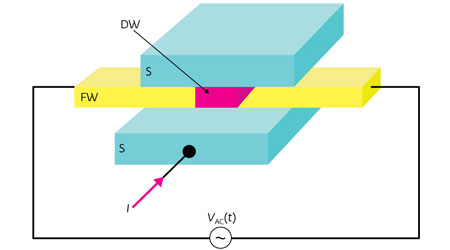| Oct 26, 2012 |
Measuring microscopic magnets
|
|
(Nanowerk News) At microscopic scales, magnetic materials are full of structure. Tiny magnets, called domains, order themselves in ways that control the magnetic properties of the bulk material. Technologies such as hard disk drives exploit this order by storing information in individual domain directions. In the past decade, however, engineers and scientists have focused increasingly on what happens between—rather than within—domains. They have also proposed new logic, memory, sensing and communication devices that manipulate the walls separating neighboring domains. Now, Shin’ichi Hikino from the RIKEN Advanced Science Institute, along with three Japan-based colleagues, has proposed a new and highly sensitive experimental technique for measuring domain wall motion ("Towards precise measurement of oscillatory domain wall by ferromagnetic Josephson junction ").
|
 |
| Figure 1: Schematic illustration of a ferromagnetic Josephson junction used for detecting magnetic domain wall motion. A domain wall (pink) inside a ferromagnetic wire (FW) between two superconducting electrodes (S) is driven into oscillatory motion by a voltage (bottom) applied horizontally across the wire. The current and voltage vertically across the junction become a precise multiple of the domain wall oscillation frequency. (© 2012 American Institute of Physics)
|
|
The researchers adapted the technology behind one of the most precise known measures of voltage. The approach uses two superconductors separated by a thin layer of non-superconducting material. When the thin junction, called a Josephson junction, is exposed to microwave radiation, the voltage across the junction becomes a precise multiple of the microwave frequency. In fact, this multiple can be defined entirely in terms of fundamental physical constants, leading to a measurement precision so high that it is used to define the value of a volt by standards institutes around the world.
|
|
Hikino and colleagues realized that, if the non-superconducting layer was made from a ferromagnet containing two or more magnetic domains (Fig. 1), the motion of the domain walls could be measured with a similarly high precision. This is due to the fact that each moving wall has a magnetic moment, which affects the current and voltage across the junction. In their theoretically proposed experimental setup, a voltage applied to the ferromagnetic wire causes its domain walls to oscillate. Then, the measured current and voltage across the junction become a precise multiple of the walls’ oscillation frequency, which plays the role of the microwave radiation frequency usually used.
|
|
As a result, the junction voltage can be used to measure the wall oscillation frequency with a precision six orders of magnitude better than conventional methods, which have errors of one part in a thousand or worse. The expected size of both the current and voltage across the junction are in the micro-ampere and micro-volt range for a ferromagnetic wire with a thickness of five nanometers. These quantities are easily measured, making the proposal experimentally feasible.
|
|
Hikino expects the technique to be applicable to uniform domain wall motion as well, and believes the approach could form the basis for a standard unit for magnetic dynamics, similar to the volt.
|

